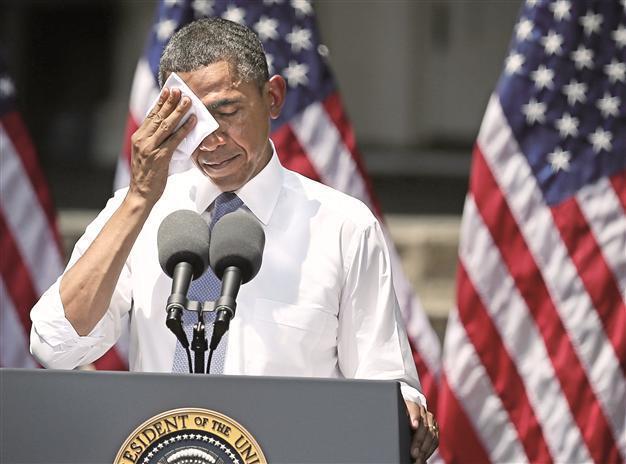Obama unveils new plan on climate change, pledging to bypass Congress
WASHINGTON

US President Obama wipes his face as he speaks about climate change at Georgetown University in Washington. The president proposes sweeping steps to limit carbon emissions from power plants and to boost renewable energy production. AFP photo
U.S. President Barack Obama launched his climate change agenda, promising new rules to cut carbon emissions from U.S. power plants and other domestic actions including support for renewable energy.
Temperatures are rising, sea level is climbing, the Arctic ice is melting and the world is doing far too little to stop it, the president warned in a speech at Georgetown University on June 25, taking off his jacket and wiping his face for visual effect.
“I refuse to condemn your generation and future generations to a planet that’s beyond fixing,” he said, unveiling his most sweeping plan yet to tackle pollution and global warming by using the executive powers of his office. His announcement followed years of inaction by Congress on the issue, and his plan would not need lawmakers’ approval.
At the core of Obama’s plan are the first-ever federal controls on new and existing power plants that emit carbon dioxide, heat-trapping gases blamed for global warming. The program also will boost renewable energy production on federal lands, increase efficiency standards and prepare communities to deal with higher temperatures. Obama also called for the U.S. to be a global leader in the search for solutions.
No time for ‘flat-earth society’ meetingAnnouncing he will allow more renewable energy projects on public lands, Obama set a goal to power the equivalent of 6 million homes by 2020 from sources like wind and solar, effectively doubling the current capacity. His proposals also include new fuel efficiency standards for heavy-duty trucks, more aggressive efficiency targets for buildings and appliances and $8 billion in federal loan guarantees to spur innovation.
But his campaign will face extensive obstacles, including the likelihood that the limits on power plants will be challenged in court. Obama also offered a rare insight into his deliberations on whether to approve the hotly debated Keystone XL oil pipeline, deeming it in U.S. interests only if it doesn’t worsen carbon pollution. The pipeline would carry carbon-intensive oil from Canadian tar sands to the Texas Gulf Coast refineries. Canada weighed in on Obama’s remarks, saying it did not think there would be a net increase in carbon emissions if the proposed pipeline from the Alberta oil sands to Texas is built, according to the country’s natural resources minister.
The president also mocked those who deny that humans are contributing to the warming of the planet. “We don’t have time for a meeting of the flat-earth society,” Obama said.
Obama’s first-term attempt to reduce climate-warming carbon emissions in a “cap and trade” system was thwarted by Congress, and his administration’s long process of studying whether to approve the Keystone XL pipeline has raised hackles from business groups and Republican critics. With Congress unlikely to pass climate legislation, Obama said his administration would set rules using its executive authority. “If Congress won’t act soon to protect future generations, I will.”
Obama’s long-awaited climate plan drew criticism from the coal industry, which would be hit hard by carbon limits, and Republicans, who accused the Democratic president of advancing policies that harm the economy and kill jobs. Environmentalists largely cheered the proposals, though some said the moves did not go far enough.
